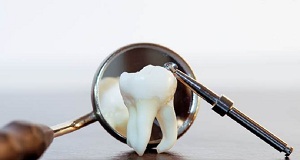 Teeth of wisdom to modern man inherited from ancestors who had to chew hard and rough food.
Teeth of wisdom to modern man inherited from ancestors who had to chew hard and rough food.
Nowadays the G8 in most cases do not perform any functionality, but only deliver a lot of trouble to a person.
Teething wisdom teeth are always accompanied by pain. In addition, the molars that have erupted can get sick, and make people uncomfortable.
Contents of
- Not yet come out, but it hurts. ..
- Neurological pains
- It's got out and it hurts - what, how, why?
- What to do with pericoronite
- What should I do?
- Caries spares no one, not even "wise"
- Helping
- Helping with pulpitis
- What should I do?
- What is periodontitis and how is it treated?
- Therapeutic measures
- Presence of a cyst in the tooth is dangerous
- When it is necessary to remove the "eight"
- How to relieve the pain quickly?
- Popular methods
- Preventive measures
Not yet got out, but it hurts. ..
The first pain sensation wisdom tooth delivers at the stage of eruption. The fact is that third molars erupt at the age of 17 to 25 years, although they may even later, depending on the individual characteristics of the person.
The tooth breaks through the bone and soft tissue, resulting in aching pain. It should be noted that by this time the bone tissue is fully formed, which complicates the eruption of eights.
Due to lack of space in the mouth for the "eights", they often grow up incorrectly. The tooth can grow horizontally, sideways or inclined. In any of these cases, eruption is accompanied by pain. When the wisdom tooth "pushes" on the "seven", the whole dentition may shift, the so-called crowding of the teeth.

In this case it can hurt not only in the area of the wisdom tooth, but the entire jaw.
At the pressure of the "eight" on the roots of neighboring teeth there is pain of a chronic nature, as well as swelling of the cheek or gum.
Often, eruption causes an inflammatory process that can accompany the following symptoms:
- acute dental pain or aching;
- swelling of the gums and cheeks;
- increased body temperature.
Neurological pains
Often the inflammatory process, localized in soft tissues, spreads to the roots of nerve endings. In this case, the eruption of the wisdom tooth can be accompanied by a headache, as well as pain in the ear or throat.
Pain sensations can occur in the neck or cheeks. Sometimes a person does not correctly determine the cause of pain, and for a long time he cures tonsillitis, while inflammation in the area of wisdom tooth continues to develop.
I got out and it hurts - what, how, why?
The third molar can be sick after the end of the eruption. 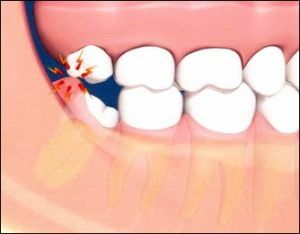
The reasons why the wisdom tooth hurts after he got out may be different, but more often it is:
- pericoronite;
- caries;
- acute or chronic pulpitis;
- periodontitis;
- cyst.
What to do with perikoronite
When a wisdom tooth appears on the gums, a fold is formed, which dentists call a "hood".Fragments of food easily fall under this fold, thereby creating excellent conditions for the reproduction of bacteria. Inflammation of the "hood" is called pericoronite.
This disease is accompanied by the following symptoms:
- pain in the region of the extreme tooth;
- gingival puffiness;
- bad breath.
Sometimes pus can be pus out from under the fold.
What should I do?
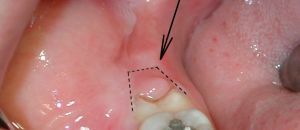 If the inflammation is not severe, it can be remedied at home. To do this, rinse your mouth with special antiseptic solutions( you can buy in a pharmacy) or decoction of herbs( sage, oak bark, chamomile).
If the inflammation is not severe, it can be remedied at home. To do this, rinse your mouth with special antiseptic solutions( you can buy in a pharmacy) or decoction of herbs( sage, oak bark, chamomile).
Also the place of inflammation should be lubricated with gel Holilsal, which has an anti-inflammatory and analgesic effect. After applying the medication for a couple of hours, you must stop eating food and drinks. Repeat the procedure 2-3 times a day.
If the violation is accompanied by purulent discharge, then the visit to the doctor can not be postponed. To relieve the symptoms, you can rinse your mouth and apply anti-inflammatory ointments. The doctor carries out excision of the "hood", and also prescribes a course of antibiotics, analgesics and anti-inflammatory drugs.
Caries does not spare anyone, not even the "wise"
Because of the inconvenient location, extreme teeth are more likely to suffer from tooth decay. They are harder to clean from plaque and food debris, which contributes to the development of caries. About tooth damage can signal:
- acute or aching pain;
- is hypersensitive when consuming hot, cold or acidic foods.
Assisting
Acute pain caused by caries in the G8 can be removed with an anesthetic drug. It is necessary to visit a dentist who decides whether to treat a third molar or it needs to be removed.
If the tooth has grown vertically, and you can get to it with a drill, it is treated. In addition, preservation of the molar is possible if it is necessary for the installation of a bridge( it will perform the function of support).
In other cases, the doctor recommends removal of the outer tooth.
Help with pulpitis
Wisdom teeth are prone to pulpitis, as are the rest of the teeth. Inflammation of the pulp can occur in acute or chronic form. With  acute pulpitis, the pain is spontaneous.
acute pulpitis, the pain is spontaneous.
Acute pain attacks may occur after exposure to stimuli, such as hot food, or by themselves. Often the pain is worse at night.
With a chronic form of the disease, the pain becomes more aching. It can appear periodically, often after exposure to the stimulus.
After eliminating the effects of cold or hot food on the wisdom tooth for 10-15 minutes, the pain can subside.
What should I do?
For pain relief, drink anesthetic. If there is no possibility to visit a doctor in the near future, try to reduce the effect of irritants, that is, for a time give up a lot of hot and cold drinks and food.
Contact your dentist to remove the tooth. Treatment of pulpitis "eights" is rare.
What is periodontitis and how is it treated?
Inflammation of the gum in the area of the wisdom tooth has the following symptoms:
- aching pain;
- strengthening of painful sensations at a bite of a tooth;
- swelling of the gums and / or cheeks.
The chronic form of the disease can also be accompanied by purulent secretions in small amounts.
Therapeutic measures
Disease is dangerous due to the development of complications. Inflammation can get purulent form, as well as go to bone tissue. This is fraught with loosening of the teeth and their loss.
In case of severe pain and swelling of the cheek and gum, consult a doctor.
The doctor will remove the wisdom tooth and prescribe a course of treatment with anti-inflammatory and other drugs. Selection of medicines depends on the course of the disease and the individual characteristics of the patient.
Presence of a cyst in the tooth - it's dangerous
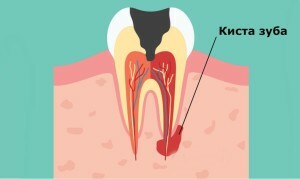 The appearance of a cyst on the wisdom teeth is quite common. Through the "hood" in the root of the wisdom tooth, as well as in the jawbone, bacteria enter. This leads to infection of bone cells, as a result of which the latter die.
The appearance of a cyst on the wisdom teeth is quite common. Through the "hood" in the root of the wisdom tooth, as well as in the jawbone, bacteria enter. This leads to infection of bone cells, as a result of which the latter die.
A cavity is formed in the bone, which eventually overgrew the shell. The appearance of the cyst irritates the root of the tooth and nerve endings, which provokes severe pain. In addition, the cyst is accompanied by the appearance of flux and suppuration.
When you need to delete the "eight"
Often the only correct solution to getting rid of toothache is the removal of wisdom teeth. Usually, the doctor before doing the surgery, makes x-rays to assess the location of the tooth, and also decide whether the last tooth can be useful.
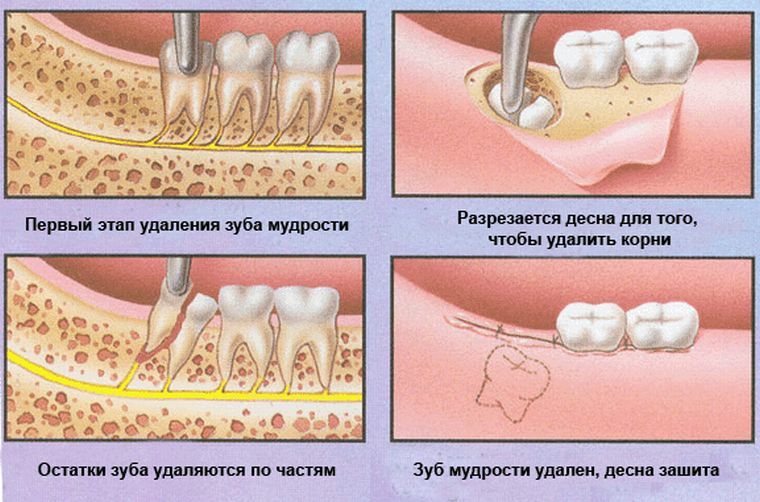
The main indications for the removal of the wisdom tooth are:
- Incorrect tooth arrangement .If the third molar grows sideways or horizontally, which often occurs because of a lack of space, it must be removed. When a tooth rests against a neighboring tooth, it also needs to be removed. In this case, it is often necessary to carry out the treatment of the seventh tooth, since enamel can be broken.
- Tenderness of the dentition .If teething has become the cause of the displacement of several teeth or the entire dentition, it is also subject to removal. Only the bracket system can correct the crowding.
- There is not enough room to erupt .If the eruption of the tooth is accompanied by very severe pain, and the doctor has found that there is no place for it, then the extreme tooth can be removed even before it completely appears over the surface of the gum. Removal in this case not only relieves pain, but also helps to avoid many problems, including the crowding of teeth.
- Pericoronite .When the "hood" is inflamed, it is also recommended to remove the wisdom tooth. Sometimes it is enough to cut a gum fold to prevent the re-development of the disease. In this case, if there are no other indications for removal, the tooth is left.
- Strong caries .If the crown of the tooth or its canals is badly damaged by caries, the wisdom tooth is removed.
- Pulpit .Inflammation of the pulp is also an indication for the removal of the third molar.
How to relieve the pain quickly?
Toothache can be removed quickly at home. To do this, in any pharmacy you need to buy painkillers( Nurofen, Ibuprofen, Nimesil, Nize, and so on).
A strong remedy that quickly eliminates pain is Ketanov, but it can not take more than three days.
To reduce the inflammatory process, which is accompanied not only by tooth pain, but also swelling and pain of the gums or cheek, anti-inflammatory drugs, for example, Holisal, Calgel, Metrogil Denta and so on, will help.
Folk methods
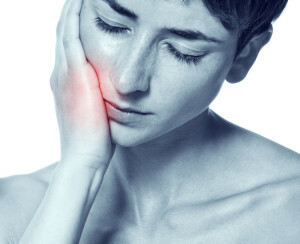 Some people, to anesthetize the wisdom tooth, resort to folk medicine. They use decoctions of herbs, lotions or appliques.
Some people, to anesthetize the wisdom tooth, resort to folk medicine. They use decoctions of herbs, lotions or appliques.
Nontraditional remedies can sometimes ease the course of the inflammatory process, but do not eliminate the problem. That is why a visit to a doctor is mandatory.
A decoction of sage, chamomile or oak bark, and also solutions of soda or salt are used to rinse the oral cavity.
Folk remedies in this case perform a supporting role and accelerate the treatment of the inflammatory process.
Preventative measures
The best prevention is the removal of wisdom tooth. Especially in cases where the tooth is still at the stage of eruption is a lot of problems. If the tooth is cut almost unnoticeably, and there is no indication for its removal, pay special attention to it when brushing your teeth.
After eating, rinse your mouth so that there is no food left in the tooth that provokes caries and other diseases. In addition, do not forget to visit the dentist regularly for examination.
